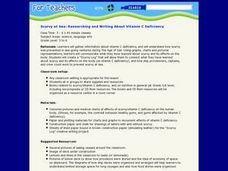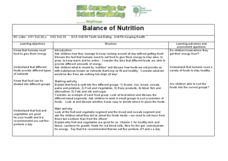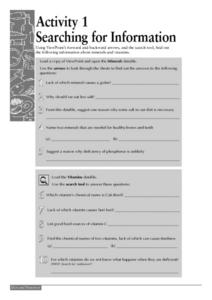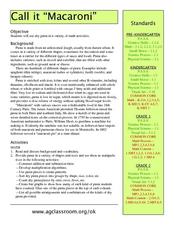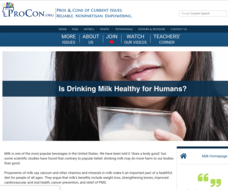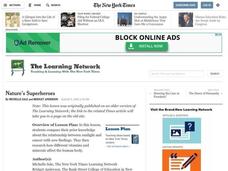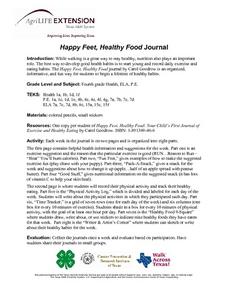Curated OER
Basic Vitamins: Water-Soluble and Fat-Soluble
An incredibly thorough lesson on vitamins, and how to keep one's body at peak health. Learners access a variety of excellent worksheets embedded in the plan that have them consider raw vs. cooked foods, a vegetable nutrition summary,...
Curated OER
Nutrition Crossword
In this crossword puzzle worksheet, students read the clues that relate to vitamins and nutrition. Students find 4 words to complete the puzzle.
Curated OER
Scurvy at Sea: Researching and Writing About Vitamin C Deficiency
Students gather information about vitamin C deficiency, and research how scurvy was prevented in sea-going ventures during The Age of Sail. They create a "Scurvy Log" that will allow them to connect what they have learned about scurvy...
Curated OER
Balance of Nutrition
Students explore nutrition by completing a group activity. In this balanced meal lesson, students identify the five food groups and discuss their favorite foods from each group. Students utilize illustrations to fill in a fictional plate...
Curated OER
Searching for Information
In this computer worksheet, students use ViewPoint's forward and backward arrows, and the search tool to locate information given about minerals and vitamins. They load the Vitamins datafile and use the search tool to respond to five...
Curated OER
Call it "Macaroni"
Who knew there were so many fun educational opportunities featuring pasta? Scholars read a brief informational text about the history of pasta (note that "macaroni" is spelled two different ways, so address this if kids are reading...
Curated OER
Food Labels in the Classroom
Young scholars study the nutritional information on food labels and become familiar with the basic dietary needs of the human body. They write letters to food companies.
Curated OER
Rice Nutrition
Third graders investigate nutrition by researching rice. In this food lesson, 3rd graders read about the healthy aspects of rice and how many people in the world eat it. Students read nutrition labels and discuss the...
Curated OER
Figuring Out Food Labels
Students identify various sources of nutritional information and evaluate accuracy of messages. They comprehend and identify misrepresentations in current food labeling. Pupils evaluate specific consumer products for truth in labeling....
Curated OER
The Quicker the Better? Food Processing
Sixth graders evaluate the nutrition of various foods. In this healthy eating lesson, 6th graders discuss the processing of many common foods and what this means. Students identify and research unfamiliar ingredients in processed foods...
Curated OER
ADULT ESOL LESSON PLAN--Level 2--Health and Nutrition
Students, while extensively reviewing the vocabulary terms on the board, examine basic food groups along with their food labels to help maintain a healthy dies for proper health.
Curated OER
ADULT ESOL LESSON PLAN--Communicate Effectively on Health and Nutrition Topics
Students, after encountering an intense vocabulary list on every day medications, identify various ways to ask for assistance with over the counter medications and their usage. In addition, they develop a set a flash cards to assist them...
Curated OER
Organize Your Favorites (Food)
In this healthy foods worksheet, students organize the names nutrient-rich foods into categories. Students also read passages about nutrition and respond to three short-answer questions.
Curated OER
Kumara Math
Students explore nutrition by completing math problems in class. In this food conversions lesson, students identify what the kumara plant is and how it can contribute to human health by regularly consuming an appropriate amount. Students...
Curated OER
Nutrition Track
Students examine the importance of a healthy diet based on the USDA food pyramid. They log their daily food intake in a journal. They create charts to analyze and compare their diets to the USDA recommended allowances.
ProCon
Milk
Milk: It does a body good ... or does it? Using the provided website, scholars sort through information to answer the question. They review a chart demonstrating lactose intolerance by ethnicity and region, and they also compare the...
Curated OER
Nature's Superheroes
Learners compare their prior knowledge about the relationship between sunlight and cancer with new findings. They research how different vitamins and minerals affect the human body.
Curated OER
Mystery Fruits and Vegetables: Why They Are Important to Us
Students discover the importance of eating fruits and vegetables. In this health lesson, students participate in a guessing game, trying to identify fruits and vegetables without seeing them. Students discuss the importance of a well...
Curated OER
Mystery "F & V's"
Fourth graders explore agriculture by reading assigned text about produce. In this fruits and vegetables instructional activity, 4th graders identify the healthy benefits of consuming fresh produce and what minerals and vitamins they...
Curated OER
Happy Feet, Healthy Food Journal
Fourth graders record their physical activities and eating habits in a journal. They place their answers in the workbook, Happy Feet, Healthy Food. They sketch and write about their weekly healthy habits.
ProCon
Vegetarianism
What do Mike Tyson, Ellen DeGeneres, and Paul McCartney have in common? They're all famous vegetarians. Using the resource, scholars learn about the pros and cons of eating a vegetarian diet. They read a fascinating history of...
Curated OER
Milk Moustache Photo Brochure
Students investigate the steps in creating a brochure using information about milk and its health benefits. Using expository writing, an information packet is created with pictures of students wearing their milk moustaches.
Curated OER
Food Math
Fourth graders explore healthy habits by completing caloric measurement activities. In this food choice lesson, 4th graders discuss what types of foods give you protein or fat and utilize a food chart to measure caloric intake. Students...
Curated OER
Performance Poppers
Students examine the controversies surrounding the use of performance-enhancing supplements in sports by interviewing athletes and writing feature articles that compare the skills required to compete in different sports.




